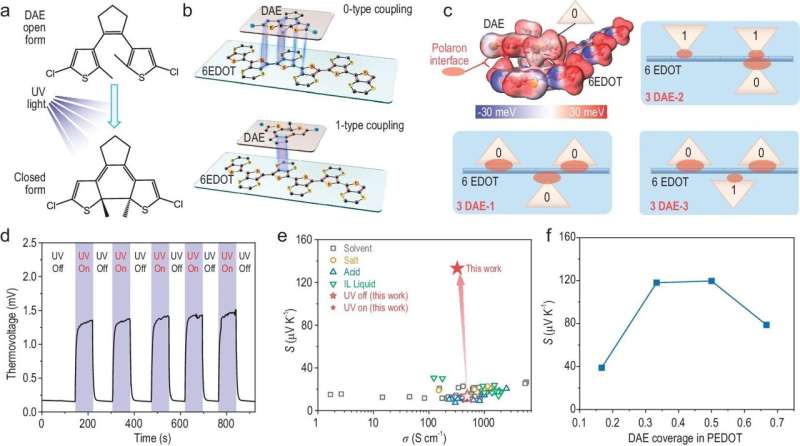This article has been reviewed according to Science X's editorial process and policies. Editors have highlighted the following attributes while ensuring the content's credibility:
fact-checked
trusted source
proofread
Polaron interfacial entropy as a route to high thermoelectric performance in DAE-doped PEDOT:PSS films

Among organic thermoelectric materials, PEDOT:PSS (poly(3,4-ethylenedioxythiophene-poly(4-styrenesulfonate)) thin films have received extensive attention but suffer from low Seebeck coefficients of 10–20 μV K-1 due to the high oxidation states in the PEDOT polymer chain. Considerable effort has been devoted to increasing the Seebeck coefficient.
One strategy is to alter the oxidation state of the ethylenedioxythiophene unit from quinoid to benzoid by posttreatment with a reducing solution. Alternatively, enhancement of the thermoelectric performance was achieved by adding inorganic thermoelectric nanoparticles such as Bi2Te3 and Te. However, it remains difficult to overcome the intrinsic coupling between the Seebeck coefficient and the electrical conductivity.
In a research article published in the National Science Review, scientists from Southern University of Science and Technology, Peking University, and Institute of Chemistry, CAS report direct manipulation of the polaron interfacial occupied entropy in a PEDOT:PSS thin film with UV light-induced resonance between PEDOT and diarylethene, thereby realizing a 10-fold thermopower enhancement from 13.5 μV K-1 to 135.4 μV K-1 with almost unchanged electrical conductivity.
They introduced an interface state to tailor the polaron interfacial occupied entropy of PEDOT:PSS with a photochromic DAE. The stereo structure of DAE molecules could transform from open-ring structure to closed-ring form under UV light.
A new polaron interface state was formed between the planar closed-ring DAE and the PEDOT molecular chains due to their similar C-C=C-C bonds, which were coupled with each other via weak interactions. The polarons effectively introduce new electronic states or sites where charge carriers can be accommodated. The occupation of these states contributes to increased entropy because it expands the possible arrangements of charge carriers.
This increase in entropy can have a significant impact on the thermopower (Seebeck coefficient) of the material. More available electronic states, as provided by the polarons at the interface, can result in an increase in the thermopower by allowing more charge carriers to participate in the thermoelectric process.
By manipulation of the polaron interfacial occupied entropy in a PEDOT:PSS thin film with UV light-induced resonance between PEDOT and diarylethene, they realized a 10-fold thermopower enhancement from 13.5 μV K-1 to 135.4 μV K-1 with almost unchanged electrical conductivity. In addition, they also observed the increased thermopower of the as-prepared PEDOT:PSS-xDAE thin films depending on the DAE concentration and UV light intensity.
They also used Raman spectra to obtain direct experimental evidence for the coupling between DAE and PEDOT under UV modulation. Therefore, resonant coupling between the DAE and PEDOT was verified by the temperature-dependent thermopower and bonding energy by DFT calculation.
In summary, they have uncovered a direct manipulation method for the polaron interfacial occupied entropy in a PEDOT:PSS thin film through UV-induced resonant coupling between DAE and PEDOT. Their work provides insight into decoupling the connection between the thermopower and the electrical conductivity of an organic thermoelectric film.
Furthermore, this work also adds a new route to engineer the thermoelectric organic thermoelectric and a unique platform for coupling the UV light, temperature gradient, and electrical field.
More information: Jiajia Zhang et al, Polaron interfacial entropy as a route to high thermoelectric performance in DAE-doped PEDOT:PSS films, National Science Review (2024). DOI: 10.1093/nsr/nwae009
Provided by Science China Press





















